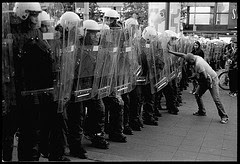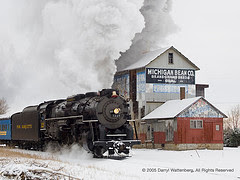According to McREL (Mid-continent Research for Education & Learning) "setting objectives establishes direction for learning. We have so many sets of "objectives" in the classroom: state standards, district curriculum standards, teacher objectives, learner objectives and intangible classroom behavioral ojbectives. Trying to address these objectives can be a daunting task and can leave a young teacher just shrugging their shoulders every time someone says "How does the lesson match-up with the state standards? How do you know the learner has met the objective?" It's such a nebulous topic. How do you measure learner outcomes, understanding?
How do you measure understanding while giving differentiation (addressing & engaging different learning styles) a fair shake? Does one student who can sketch a detailed picture of an African slave's voyage in the 16th century understand the lasting effects of the Triangular trade & Middle Passage over a student who can write and essay on the topic? How do you measure that? How do you quantify differentiated assessments?
Every day my target market gets more tech-savvy. Each day they rely more and more on technology. It is the lense through which teenagers see the world. Those in my age range (late 20s, early 30s) blog and text and facebook and twitter (I'm not quite there...yet), but we are on the archaic end of the Millenial generation. When attempting to meet objectives (whether they are state standards or lesson objectives) I find a tenuous struggle between using the "stick & the sand" philosophy (Big Dan Teaching Law #1: "All a good teacher needs is a textbook & a chalkboard, the best teachers just need a stick and a clear spot of sand") and teaching through a conduit of technological resources. Some days I am at the whiteboard with different colored dry erase markers and other days I am whiz-banging through a touch screen interface on my Polyvision board. Both have their advantages, both have their pitfalls. Finding and balancing a good blend has been the task of my fourth year...How do you keep the attention of the Millenials, cover/deliver/teach the content and then effectively and accurately assess the learners...?
What I have humbly learned is this: you can always teach without technology, there is no shame in it. BUT, I have found that technology allows for, as McREL studies point out, "narrowing student focus, personalizing learning goals, flexibility in personalizing learner goals and communicating learning objectives to students and parents." Technology, as long as it is up and running, is a juggernaut in the classroom experience. The model of a teacher at the chalkboard is not obsolete, it's simply something that should be done in small doses. Afterall, some things still need to be modeled face-to-face in front of the class: instructing students on developing a 5-paragraph essay, outline note-taking skills, answering class questions, illustrating concepts in impromptu discussions, etc. Technology allows for varied experiences quickly and also allows for the personalization of learner goals.
Today, while working an assignment a student, who needed to look something up on the internet, took his new Drone phone out his pocket. I usually nab phones in a fun "me versus them" game...I even keep a tally mark on the bulletin board behind me...It's not that phones bother me, it's simply school policy and I have made a game out of it with the kids...But, this kid asks "Mr. Anderson, can use my phone to look for flags of the Netherlands & Spain?" I stopped, looked down and he had already navigated his way to the "Bing" decision engine. And, there on his phone were images of flags from the Dutch East India Co.
I just shook my head, smiled and said, "I guess so."
Wednesday, February 24, 2010
Subscribe to:
Post Comments (Atom)




No comments:
Post a Comment